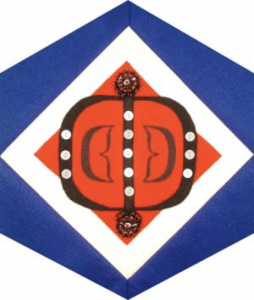Haisla

The Block
Peggy Ross designed the Haisla block, which features traditional beadwork on a base of soft, white antelope hide and a painted, split U pattern on red Melton cloth. Such U-shapes, which often adorn dancing regalia, are the basic building blocks of Pacific Northwest flat-form designs, and can be used to delineate various parts of these designs, such as claws, ears, arms, tails, and wings.
Cultural Profile
For thousands of years the Haisla people have lived in the Kitimat area, near the Douglas and Gardner Canals; a traditional territory of about 4 million acres along the northwest coast of British Columbia. The name “Haisla” (/xÜ?is@la/) means “those living at the river mouth” or “living down river.” Their language is of the Wakashan linguistic family.
Hunting and fishing, and foraging for plants and berries became well-honed survival skills. In the spring many Haisla families travelled to the Kemano River to fish for oolichan, which was the first fish species to return to rivers each year to spawn. Oolichan was “soulfood” and central to Haisla life and culture. In addition to using the fish as a source of food and medicine, the oolichan was also boiled to form grease. The resulting pure white grease was, and continues to be, a valuable trading commodity.
The Haisla hunted goats, black bears, beaver and moose; a tradition that has been passed down through the generations. Each year salmonberries, cranberries, huckleberries and strawberries were harvested to supplement their diet. To preserve the berries for the winter months, the Haisla mashed them with oolichan grease and stored the mixture in leaf-lined wooden containers. Other indigenous plants were gathered and used to prepare medicinal remedies that are still used by Haisla descendants. The Haisla built canoes and totem poles from the great cedar and spruce trees of the area. The bark was used to weave baskets, rope and clothing, while the sap was used as a sealant for their canoes.
Today, about half of the Haisla First Nation live in Kitamaat Village, which is located at the head of Douglas Channel. Its name, Kitamaat, was first bestowed by a group of Tsimshian on a winter trip to the area. Upon spying a mass of heads that moved along the snow-covered shoreline someone said, “Git-a-maat”, meaning, “There pass the people of the snow.” In fact, Haisla men were only partially visible as they traveled along paths dug through deep snow, but the title stuck. In Haisla, the Kitamaat Village is called “Tsee-Motsa,” which means Snag Beach.
The Haisla people value and maintain their culture and customs through a strong oral tradition and a deep connection to the land. Language training and camps have fostered a cultural revival among Haisla youth.
Sponsor: Agnes Cooper
